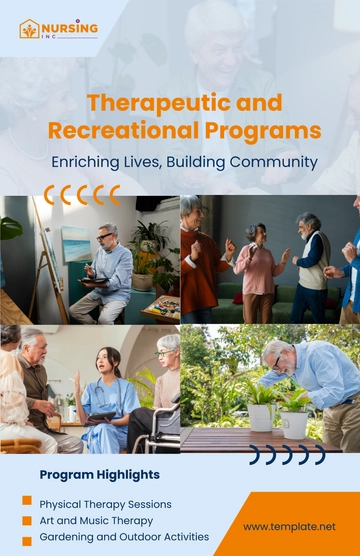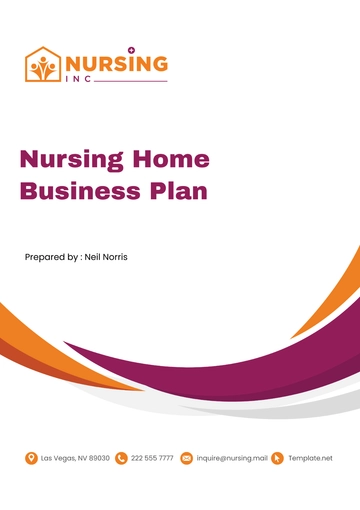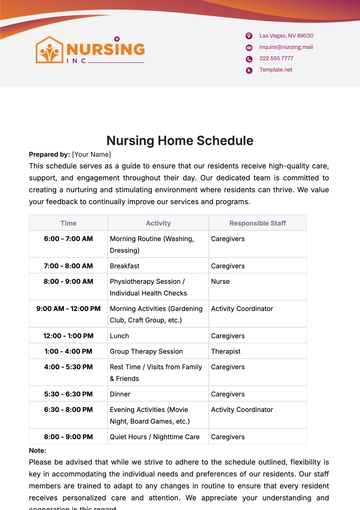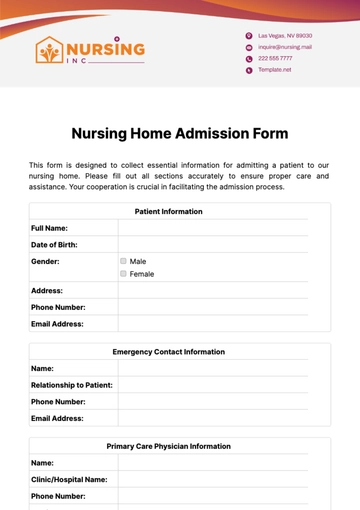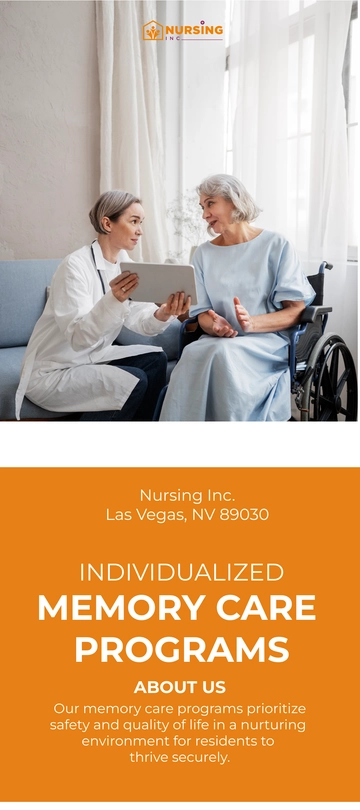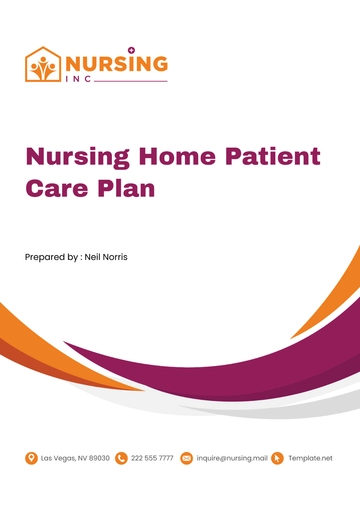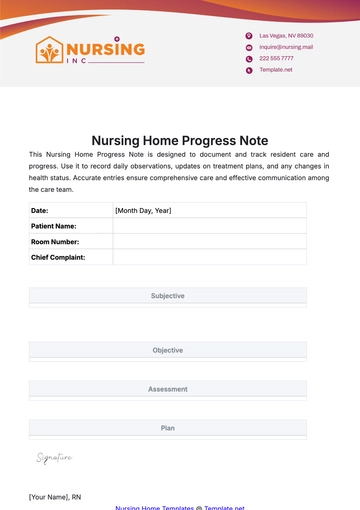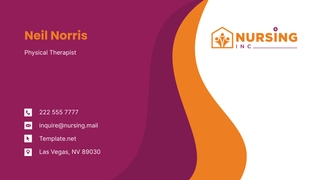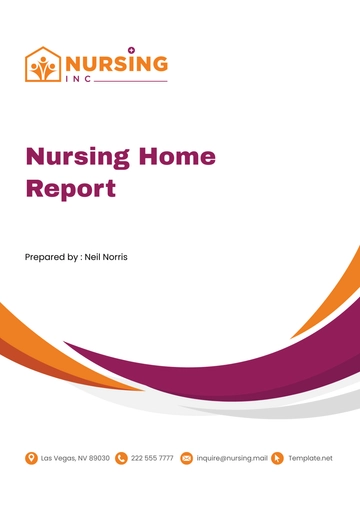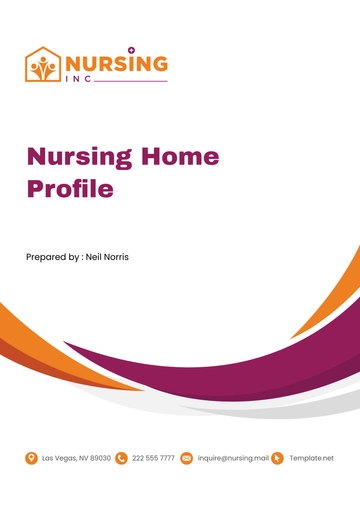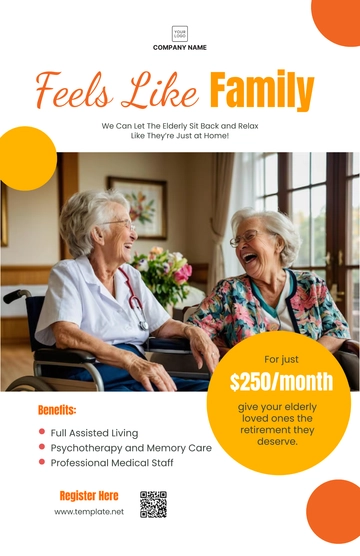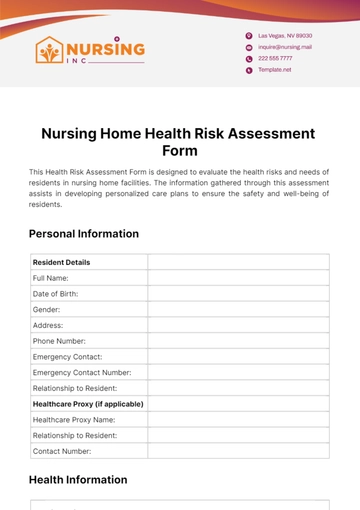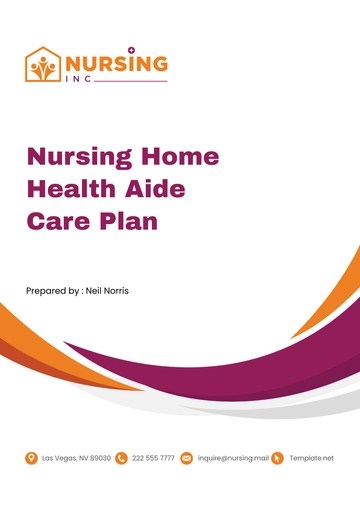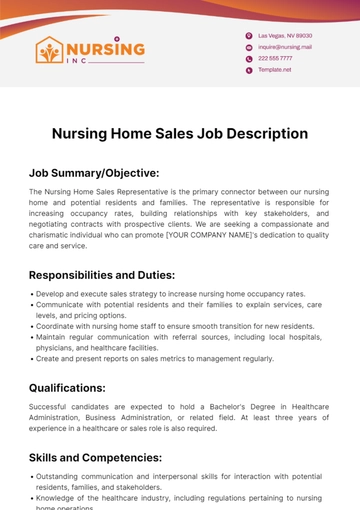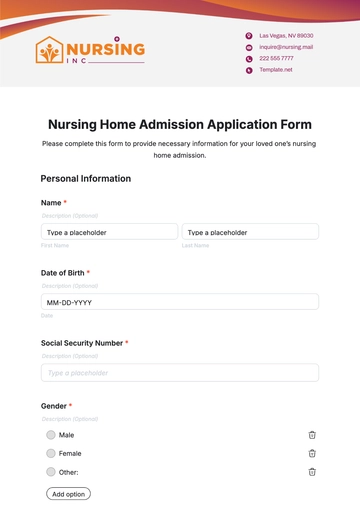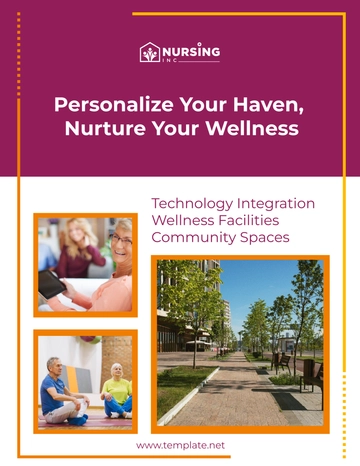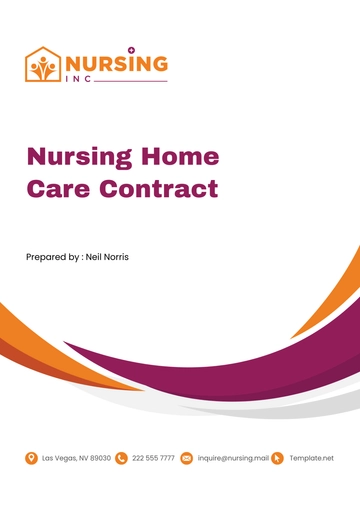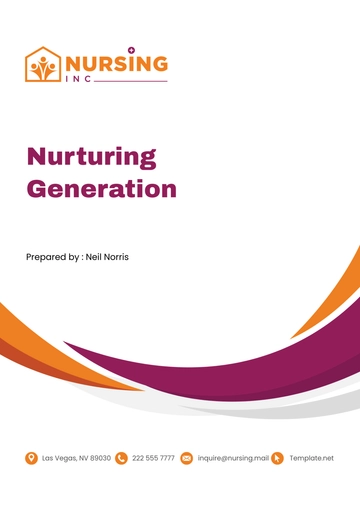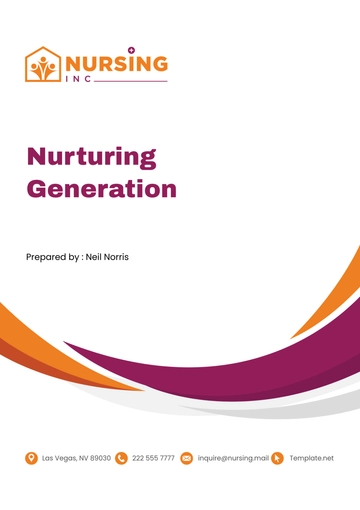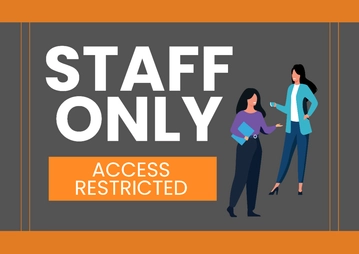Free Nursing Home Resident Evacuation Protocol Guide
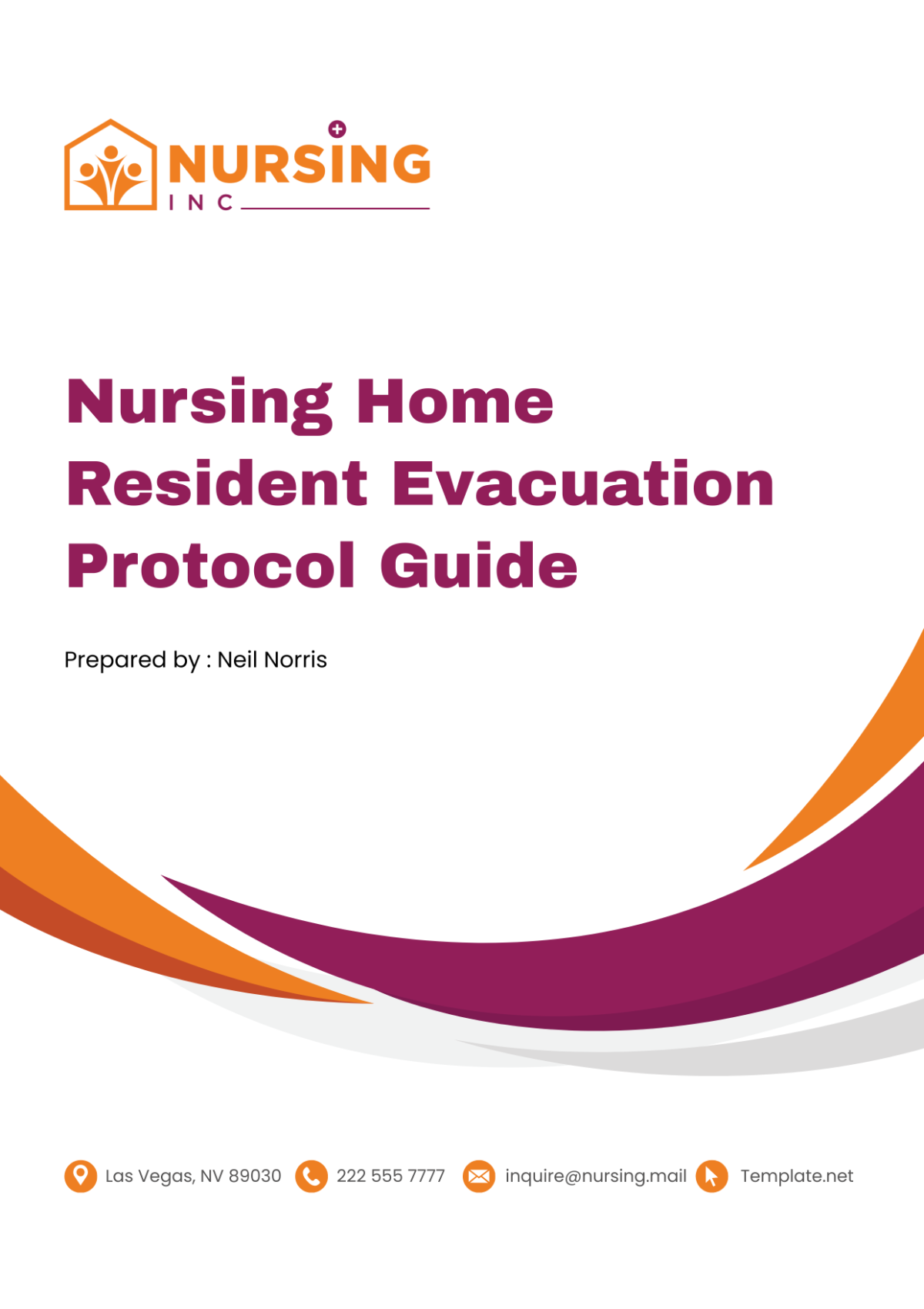
I. Introduction
A. Objectives of the Guide
To ensure safety: The primary purpose of this guide is to ensure the safety and well-being of all residents in the event of an emergency that requires evacuation. This involves outlining procedures that minimize risk and maximize the efficiency of the evacuation process.
To provide clear instructions: This guide provides clear, step-by-step instructions for staff to follow during an evacuation. These instructions are designed to be easy to understand and implement, even under stressful conditions.
To comply with regulations: This guide helps [Your Company Name] comply with local, state, and federal regulations regarding emergency preparedness in nursing homes. It outlines the necessary steps to meet or exceed these regulatory requirements.
To facilitate training: This guide serves as a training manual for staff, helping them understand their roles and responsibilities during an evacuation. It provides a basis for training sessions and drills.
To promote communication: This guide promotes effective communication among staff, residents, and their families during an evacuation. It outlines the communication channels and protocols to be used during an emergency.
B. Scope of the Guide
Who it applies to: This guide applies to all staff, residents, and visitors at [Your Company Name]. It outlines the roles and responsibilities of each group during an evacuation.
When it applies: This guide applies whenever an emergency situation arises that requires the evacuation of the nursing home. This includes both natural disasters and man-made incidents.
Where it applies: This guide applies to all areas of [Your Company Name], including resident rooms, common areas, and outdoor spaces. It provides specific instructions for evacuating each area safely.
How it applies: This guide should be followed as closely as possible, recognizing that every emergency situation is unique and may require some adaptation. It provides a framework for decision-making during an emergency.
C. Key Definitions
Evacuation: The process of moving residents from the nursing home to a safer location due to an imminent threat.
Shelter-in-place: The process of keeping residents safe within the nursing home when it is safer to stay inside than to evacuate.
Emergency services: Professional services that respond to emergencies, such as fire departments, police departments, and ambulance services.
Emergency preparedness: The process of planning for and being ready to respond to an emergency. This includes training, drills, and the development of emergency response plans.
Emergency response plan: A plan that outlines how to respond to an emergency situation. This includes both immediate response actions and longer-term recovery efforts.
Emergency evacuation plan: A plan that outlines how to safely evacuate the nursing home in an emergency. This includes routes, procedures, and roles and responsibilities.
Emergency contact: A person or organization that should be contacted in the event of an emergency. This could include family members, doctors, or emergency services.
Emergency kit: A collection of supplies that may be needed in an emergency. This could include medical supplies, food and water, and important documents.
Emergency drill: A practice run of the emergency response plan. This helps to ensure that everyone knows what to do in an actual emergency.
Emergency coordinator: The person responsible for coordinating the response to an emergency. This includes making decisions, communicating with others, and ensuring that the emergency response plan is followed.
II. Roles and Responsibilities
A. Nursing Home Staff
Emergency Coordinator: The Emergency Coordinator is responsible for initiating the evacuation protocol, coordinating with emergency services, and ensuring the safety of all residents.
1.1. Initiating the protocol: The Emergency Coordinator is the person who makes the decision to initiate the evacuation protocol. This decision is based on a variety of factors, including the nature of the emergency, the risk to residents, and the advice of emergency services.
1.2. Coordinating with emergency services: The Emergency Coordinator is the primary point of contact for emergency services. They provide information about the situation at the nursing home, request assistance as needed, and coordinate the response.
1.3. Ensuring resident safety: The Emergency Coordinator oversees the evacuation to ensure that all residents are safely evacuated. They monitor the situation, make decisions as needed, and address any issues that arise.
Medical Staff: Medical staff are responsible for providing necessary medical care during the evacuation, ensuring that residents’ medical needs are met, and transporting medical equipment and supplies.
2.1. Providing medical care: Medical staff provide immediate medical care during the evacuation. This includes administering medications, performing first aid, and monitoring residents’ health.
2.2. Ensuring medical needs are met: Medical staff ensure that residents’ ongoing medical needs are met during the evacuation. This includes coordinating with the Emergency Coordinator and other staff to ensure that residents have the medications and medical equipment they need.
2.3. Transporting medical equipment and supplies: Medical staff are responsible for ensuring that necessary medical equipment and supplies are included in the evacuation. This includes items such as wheelchairs, oxygen tanks, and medication.
Support Staff: Support staff are responsible for assisting with the evacuation, carrying out assigned tasks, and helping to maintain calm and order.
3.1. Assisting with the evacuation: Support staff assist with the physical aspects of the evacuation. This includes moving residents, carrying equipment and supplies, and ensuring that the evacuation routes are clear.
3.2. Carrying out assigned tasks: Support staff carry out tasks assigned to them by the Emergency Coordinator or other staff. This includes tasks related to their specific roles as well as general tasks needed to ensure a successful evacuation.
3.3. Maintaining calm and order: Support staff help to maintain a calm and orderly environment during the evacuation. This includes managing resident behavior, addressing resident concerns, and providing reassurance.
Administrative Staff: Administrative staff are responsible for communicating with families, documenting the evacuation, and coordinating with external agencies as needed.
4.1. Communicating with families: Administrative staff are the primary point of contact for families. They provide updates about the evacuation, answer questions, and coordinate family assistance as needed.
4.2. Documenting the evacuation: Administrative staff are responsible for documenting the evacuation. This includes keeping records of resident locations, actions taken, and any issues that arise.
4.3. Coordinating with external agencies: Administrative staff coordinate with external agencies as needed. This includes local authorities, health departments, and other relevant organizations.
Maintenance Staff: Maintenance staff are responsible for securing the facility, assisting with the evacuation, and managing any facility-related issues that arise during the evacuation.
5.1. Securing the facility: Maintenance staff are responsible for securing the nursing home facility. This includes locking doors, turning off utilities, and addressing any safety hazards.
5.2. Assisting with the evacuation: Maintenance staff assist with the physical aspects of the evacuation. This includes moving equipment, clearing evacuation routes, and addressing any facility-related issues that arise.
5.3. Managing facility-related issues: Maintenance staff manage any facility-related issues that arise during the evacuation. This includes addressing maintenance issues, managing utilities, and coordinating repairs as needed.
B. Residents
Compliance: Residents are expected to comply with instructions given by staff during an evacuation. This includes following the designated evacuation routes and procedures, and cooperating with staff and emergency personnel.
Self-Care: To the extent possible, residents are responsible for managing their personal needs during the evacuation. This includes carrying personal belongings, taking prescribed medications, and maintaining personal hygiene.
Communication: Residents should communicate any immediate needs or concerns to staff during the evacuation. This includes health issues, discomfort, or anxiety related to the evacuation process.
Cooperation: Residents should cooperate with each other and with staff to ensure a smooth and efficient evacuation. This includes helping each other when possible, maintaining calm, and avoiding actions that could hinder the evacuation process.
C. Family Members
Communication: Family members should maintain communication with the nursing home to receive updates about the evacuation. This includes providing up-to-date contact information and checking in regularly for updates.
Support: Family members can provide emotional support to residents during the evacuation. This includes reassuring residents, providing comfort, and helping to alleviate anxiety or fear.
Coordination: Family members may need to coordinate with the nursing home and other agencies to arrange for the care of residents after the evacuation. This includes arranging transportation, temporary housing, and ongoing care.
Understanding: Family members should understand the evacuation process and the reasons for the actions taken by the nursing home. This includes familiarizing themselves with the evacuation protocol and trusting the expertise and judgment of the nursing home staff.
Patience: Family members should be patient and understanding, recognizing that the primary goal of the evacuation is to ensure the safety of all residents. This includes respecting the pace of the evacuation process and the decisions made by the nursing home staff.
III. Evacuation Procedures
A. General Evacuation Procedures
Activation of the Evacuation Plan: The evacuation plan is activated when the Emergency Coordinator determines that an evacuation is necessary. This decision is based on the nature of the emergency, the risk to residents, and the advice of emergency services.
1.1. Assessing the situation: The Emergency Coordinator will assess the situation, taking into account the type and severity of the emergency, the potential impact on the nursing home, and the likelihood of escalation.
1.2. Evaluating the risk: The potential risk to residents is a critical factor in the decision to evacuate. This includes both immediate risks and potential future risks. The Emergency Coordinator will consider the health and safety of the residents, their ability to evacuate, and the potential impact of the emergency on their well-being.
1.3. Consulting with emergency services: The advice of professional emergency services is a crucial factor in the decision to evacuate. The Emergency Coordinator will liaise with these services, taking their advice into account when deciding whether to evacuate.
Communication of the Evacuation Order: The evacuation order is communicated to all staff, residents, and visitors through the nursing home’s emergency communication system. This includes:
2.1. Making announcements: Staff make verbal announcements to inform everyone in the nursing home of the evacuation order. These announcements are clear, concise, and repeated as necessary. They will include information about the nature of the emergency, the evacuation procedures to be followed, and any specific instructions for the situation.
2.2. Using alarms: Alarms are used to signal the evacuation order. The type of alarm used depends on the nature of the emergency and the nursing home’s emergency plan. The alarms are designed to be clearly audible throughout the nursing home, alerting everyone to the need for evacuation.
2.3. Utilizing other communication methods: Other communication methods, such as intercom systems, two-way radios, or mobile devices, may be used as appropriate. These methods allow for direct communication with specific individuals or groups, providing detailed instructions and updates as the evacuation progresses.
Implementation of the Evacuation Plan: Staff implement the evacuation plan according to their roles and responsibilities. This includes:
3.1. Assisting residents: Staff assist residents in evacuating the nursing home. This includes physical assistance, emotional support, and guidance. Staff will ensure that residents are able to safely exit the building, providing help as needed for residents with mobility issues or other special needs.
3.2. Securing the facility: Staff secure the nursing home facility as part of the evacuation process. This includes locking doors, turning off utilities, and addressing any safety hazards. Staff will also ensure that all necessary equipment and supplies are taken with them during the evacuation.
3.3. Coordinating with emergency services: Staff coordinate with emergency services to manage the evacuation. This includes providing information, requesting assistance, and following instructions. Staff will liaise with emergency services throughout the evacuation, ensuring that they are aware of the situation in the nursing home and can provide the necessary support.
Evacuation of the Facility: All individuals evacuate the facility according to the designated evacuation routes and procedures. Staff assist residents as needed, and emergency services provide additional assistance as required.
4.1. Following evacuation routes: All individuals in the nursing home should follow the designated evacuation routes. These routes are designed to provide the safest and most efficient path out of the building.
4.2. Assisting residents: Staff are responsible for assisting residents during the evacuation. This includes providing physical assistance, guiding residents along the evacuation route, and ensuring that all residents have safely exited the building.
4.3. Coordinating with emergency services: Staff coordinate with emergency services to manage the evacuation. This includes providing information about the situation in the nursing home, requesting assistance as needed, and following the instructions of emergency personnel.
B. Evacuation of Mobility-Impaired Residents
Identification of Mobility-Impaired Residents: Staff identify residents who are mobility-impaired and may require additional assistance during the evacuation. This includes residents who use:
1.1. Wheelchair users: Staff identify residents who use wheelchairs and may require specialized equipment or additional assistance during the evacuation. These residents may also need priority evacuation due to their limited mobility.
1.2. Walker users: Staff identify residents who use walkers. These residents may be able to walk with assistance, but may require additional time or support during the evacuation.
1.3. Other mobility aids: Staff identify residents who use other mobility aids, such as canes or crutches. These residents may require additional assistance or specific evacuation procedures to ensure their safety.
Assistance for Mobility-Impaired Residents: Staff provide assistance to mobility-impaired residents during the evacuation. This includes:
2.1. Physical assistance: Staff provide physical assistance to mobility-impaired residents as needed. This could include helping residents to stand or walk, supporting residents as they move, or carrying residents if necessary.
2.2. Use of evacuation chairs or other equipment: Staff use evacuation chairs or other specialized equipment to assist mobility-impaired residents during the evacuation. This equipment is designed to safely and efficiently transport mobility-impaired residents during an evacuation.
2.3. Coordination with emergency services: Staff coordinate with emergency services to ensure the safe evacuation of mobility-impaired residents. This could include communicating the needs of these residents to emergency personnel, requesting additional assistance, or arranging for specialized transportation.
Priority Evacuation: Mobility-impaired residents are given priority during the evacuation to ensure their safety. They are evacuated first, or are evacuated using designated priority evacuation routes.
3.1. Evacuation order: Mobility-impaired residents are among the first to be evacuated. This ensures that they have the time and assistance they need to safely exit the building.
3.2. Priority evacuation routes: Mobility-impaired residents may be evacuated using designated priority evacuation routes. These routes are designed to be accessible for residents with mobility impairments, and are kept clear of obstacles during the evacuation.
3.3. Assistance during evacuation: Mobility-impaired residents receive additional assistance during the evacuation. This could include additional staff support, the use of specialized equipment, or assistance from emergency personnel.
C. Evacuation of Residents with Special Needs
Identification of Residents with Special Needs: Staff identify residents who have special needs and may require additional assistance during the evacuation. This includes:
1.1. Medical conditions: Residents with medical conditions, such as heart disease, diabetes, or respiratory conditions, may require additional assistance and care during the evacuation. Staff should be aware of these conditions and prepared to provide the necessary care.
1.2. Cognitive impairments: Residents with cognitive impairments, such as dementia or Alzheimer’s disease, may require additional assistance and guidance during the evacuation. Staff should be trained to effectively communicate with these residents and provide the necessary support.
1.3. Sensory impairments: Residents with sensory impairments, such as vision or hearing loss, may require additional assistance and communication support during the evacuation. Staff should be prepared to provide this support and ensure these residents’ safety.
Individualized Evacuation Plans: Staff develop individualized evacuation plans for residents with special needs. These plans outline the specific steps to be taken during an evacuation to ensure the resident’s safety.
2.1. Development of the plan: Staff work with the resident, their family, and medical professionals to develop the individualized evacuation plan. This plan takes into account the resident’s specific needs, abilities, and preferences.
2.2. Implementation of the plan: During an evacuation, staff implement the individualized evacuation plan. They follow the steps outlined in the plan and adapt as necessary based on the situation.
2.3. Review and update of the plan: Staff regularly review and update the individualized evacuation plan. This ensures that the plan remains current and effective.
IV. Emergency Equipment and Supplies
In the event of an evacuation, certain equipment and supplies are essential to ensure the safety and well-being of residents. The following table provides an overview of some of the necessary equipment and supplies in a nursing home during an evacuation:
Equipment/Supply | Definition |
|---|---|
Evacuation Chairs | These are devices designed to assist in the safe and efficient evacuation of mobility-impaired individuals down stairways. |
First Aid Kits | These kits contain medical supplies that can be used to provide immediate care for injuries. |
Emergency Food and Water | These are supplies of food and water that can be used if regular supplies are unavailable during an evacuation. |
Personal Protective Equipment (PPE) | This includes items such as gloves and masks that protect staff and residents from potential hazards. |
Communication Devices | These are devices such as two-way radios that allow for communication among staff during an evacuation. |
Medications | These are essential medications that residents may need to take on a regular basis. |
A. Use of Equipment and Supplies
Training: All team members receive comprehensive training on the use of emergency equipment and supplies. This includes operation of evacuation chairs, application of first aid techniques, and effective use of communication devices.
1.1. Regular training sessions: Regularly scheduled training sessions ensure that everyone is familiar with all equipment and supplies. These sessions include hands-on practice and may be conducted by experienced team members or external trainers.
1.2. Emergency drills: Emergency drills provide opportunities to practice using the equipment and supplies in a simulated emergency situation. This helps to ensure they can use the equipment effectively during an actual evacuation.
1.3. Updates and refreshers: Updates and refresher training are provided as needed. This ensures that everyone is up-to-date with any changes or new equipment.
Proper use: Proper use of the equipment and supplies is crucial to ensure their effectiveness and the safety of residents.
2.1. Following instructions: Instructions provided by the manufacturer are followed when using equipment. This helps to ensure the equipment works as intended and reduces the risk of damage or injury.
2.2. Prioritizing safety: Safety is always the top priority when using equipment and supplies. This includes using personal protective equipment when necessary and handling all equipment and supplies safely.
Coordination: Coordination is key to ensure that equipment and supplies are used effectively and efficiently.
3.1. Assigning roles: Specific roles related to the use of equipment and supplies are assigned to team members. This helps to ensure that all necessary tasks are covered and reduces confusion during an evacuation.
3.2. Sharing resources: Resources are shared as needed. This helps to ensure that resources are used efficiently and that all residents receive the care they need.
B. Maintenance of Equipment and Supplies
Regular checks: Regular checks are conducted to ensure all equipment and supplies are in good working order.
1.1. Scheduled checks: Checks of equipment and supplies are scheduled and conducted regularly. This helps to ensure that any issues are identified and addressed promptly.
1.2. Checklists: Checklists are used to ensure all equipment and supplies are checked. This helps to ensure nothing is overlooked and that all checks are thorough.
1.3. Documentation: The results of all checks are documented. This provides a record of the condition of the equipment and supplies and can help to identify any trends or recurring issues.
Repairs and replacements: Any necessary repairs or replacements are arranged promptly.
2.1. Identifying issues: Any issues with equipment or supplies are identified during the regular checks. This includes any damage, defects, or other problems that could affect the equipment’s operation or safety.
2.2. Arranging repairs: Necessary repairs are arranged promptly. This includes contacting the manufacturer or a qualified repair service and arranging for the equipment to be repaired.
2.3. Replacing equipment: If equipment or supplies cannot be repaired, or if it is more cost-effective to replace them, replacements are arranged. This includes ordering new equipment or supplies and ensuring they are delivered and set up correctly.
Stock management: Stock of supplies is managed to ensure there is always a sufficient quantity available.
3.1. Monitoring stock levels: Stock levels of supplies are monitored regularly. This helps to ensure there is always a sufficient quantity available and allows for timely reordering.
3.2. Reordering supplies: Supplies are reordered as needed to maintain sufficient stock levels. This includes placing orders with suppliers and checking deliveries for accuracy.
3.3. Storing supplies: Supplies are stored safely and efficiently. This includes following any specific storage requirements and organizing supplies so they can be easily accessed when needed.
V. Communication Plan
Effective communication is crucial during an evacuation. The following table provides an overview of some of the key roles and their responsibilities in the communication plan:
Role | Responsibility |
|---|---|
Emergency Coordinator | The Emergency Coordinator is responsible for initiating the communication plan, making important announcements, and coordinating with external agencies. |
Nursing Home Staff | Nursing Home Staff are responsible for communicating with residents, providing them with necessary information and instructions, and reporting any issues to the Emergency Coordinator. |
Family Liaison | The Family Liaison is responsible for communicating with residents’ families, providing them with updates, and addressing their concerns. |
Media Liaison | The Media Liaison is responsible for communicating with the media, providing them with official statements, and managing public relations. |
A. Role of the Emergency Coordinator
Making the initial announcement: The initial announcement about the evacuation is made. This includes providing information about the situation, the reason for the evacuation, and the expected actions from everyone involved.
Informing all relevant parties: All relevant parties are informed about the evacuation. This includes staff, residents, residents’ families, and external agencies.
Coordinating the communication effort: The overall communication effort is coordinated. This includes overseeing the communication activities of the staff, ensuring that accurate and timely information is provided, and addressing any communication-related issues.
B. Role of the Nursing Home Staff
Communicating with residents: Direct communication with residents is provided, giving them necessary information and instructions about the evacuation. It is ensured that residents understand what is happening and what they need to do.
Providing necessary information and instructions: Residents are provided with the necessary information and instructions for the evacuation. This includes information about the situation, instructions for evacuation procedures, and answers to any questions residents may have.
Reporting any issues: Any issues or concerns are reported to the Emergency Coordinator. This includes any communication-related issues, such as residents not understanding instructions, or issues with communication equipment.
C. Role of the Family Liaison
Providing regular updates: Regular updates about the situation and the well-being of the residents are provided to their families. This helps to keep families informed and reassured.
Addressing concerns: Any concerns raised by families are addressed promptly and empathetically. This includes concerns about the safety of residents, the progress of the evacuation, and the care being provided.
Answering questions: Any questions from families are answered in a timely and accurate manner. This helps to provide clarity and reduce anxiety.
D. Role of the Media Liaison
Providing official statements: Official statements about the evacuation are provided to the media. This includes information about the situation, the actions taken by the nursing home, and any other relevant information.
Managing media inquiries: Any inquiries from the media are managed. This includes answering questions, providing updates, and ensuring that the media has accurate and up-to-date information.
Maintaining public relations: Public relations are maintained throughout the evacuation. This includes managing the nursing home’s image, addressing any negative coverage, and highlighting the efforts of the nursing home.
VI. Post-Evacuation Procedures
A. Accounting for All Individuals
Roll Call: After the evacuation, a roll call is conducted to account for all individuals. This includes staff, residents, and any visitors who were in the nursing home at the time of the evacuation.
1.1. Conducting the roll call: The roll call is conducted in a systematic and organized manner. This includes calling out the names of all individuals and marking them as present or absent.
1.2. Identifying missing individuals: If any individuals are unaccounted for after the roll call, this is noted and reported to the Emergency Coordinator immediately.
1.3. Coordinating with emergency services: Information about any missing individuals is shared with emergency services to aid in search and rescue efforts.
Checking Evacuation Areas: All evacuation areas are checked to ensure that no one has been left behind. This includes all rooms, common areas, and outdoor spaces.
2.1. Conducting the checks: The checks are conducted systematically, with staff members assigned to check specific areas.
2.2. Reporting findings: Any findings from the checks are reported to the Emergency Coordinator. This includes any individuals who were missed during the roll call, as well as any issues or concerns with the evacuation areas.
Documenting the Evacuation: The evacuation is documented in detail. This includes the reasons for the evacuation, the procedures followed, any issues or challenges, and the outcome of the evacuation.
3.1. Recording the details: The details of the evacuation are recorded in a systematic and organized manner. This includes the date and time of the evacuation, the individuals involved, and the actions taken.
3.2. Identifying lessons learned: Any lessons learned from the evacuation are identified and documented. This includes what worked well, what didn’t work well, and what could be done differently in the future.
3.3. Updating the evacuation plan: Based on the lessons learned, the evacuation plan is updated as necessary. This helps to improve the effectiveness of future evacuations.
B. Care and Support for Residents
Medical Care: After the evacuation, necessary medical care is provided to residents. This includes administering medications, monitoring vital signs, and providing first aid.
1.1. Administering medications: Any medications that residents need to take regularly are administered. This includes coordinating with healthcare providers as necessary.
1.2. Monitoring vital signs: The vital signs of residents are monitored to ensure their health and well-being. This includes checking heart rate, blood pressure, and other vital signs.
1.3. Providing first aid: First aid is provided to any residents who have been injured or are unwell. This includes treating minor injuries, stabilizing more serious injuries, and coordinating with healthcare providers as necessary.
Emotional Support: Emotional support is provided to residents after the evacuation. This includes reassurance, comfort, and counseling services.
2.1. Providing reassurance: Reassurance is provided to residents to help them cope with the aftermath of the evacuation. This includes explaining what has happened, what is being done to ensure their safety, and what will happen next.
2.2. Providing comfort: Comfort is provided to residents to help them feel safe and secure. This includes physical comfort, such as providing blankets or warm drinks, as well as emotional comfort, such as listening to their concerns and providing empathetic responses.
2.3. Providing counseling services: Counseling services are provided to residents who need them. This includes coordinating with mental health professionals as necessary.
Assistance with Personal Needs: Assistance is provided to residents with personal needs after the evacuation. This includes help with eating, bathing, or other personal care tasks.
3.1. Providing meals: Meals are provided to residents to ensure they have the nutrition they need. This includes accommodating any dietary restrictions or preferences.
3.2. Assisting with personal care: Assistance is provided with personal care tasks, such as bathing and toileting. This includes respecting residents’ privacy and dignity.
3.3. Providing necessary supplies: Necessary supplies, such as clothing and toiletries, are provided to residents. This includes coordinating with suppliers or donors as necessary.
VII. Review and Update
A. Review
Annual Review: The evacuation protocol is reviewed at least once a year. This ensures that the protocol remains current and effective.
Post-Evacuation Review: After each evacuation, a thorough review is conducted. This includes evaluating the effectiveness of the protocol, identifying any issues or challenges, and documenting lessons learned.
Regulatory Compliance Review: The protocol is reviewed to ensure compliance with all relevant regulations and standards. This includes local, state, and federal regulations, as well as industry standards.
Stakeholder Feedback Review: Feedback from stakeholders, including staff, residents, and their families, is reviewed. This feedback can provide valuable insights into the effectiveness of the protocol and areas for improvement.
Risk Assessment Review: The risk assessment that the protocol is based on is reviewed. This includes reviewing the identified hazards, the vulnerability of the nursing home and its residents, and the potential impact of an evacuation.
B. Update
Annual Update: Based on the annual review, the evacuation protocol is updated as necessary. This ensures that the protocol remains current and effective.
Post-Evacuation Update: After each evacuation, the protocol is updated based on the post-evacuation review. This includes making changes to address any issues or challenges, and incorporating lessons learned.
Regulatory Compliance Update: If any relevant regulations or standards change, the protocol is updated to ensure continued compliance.
Stakeholder Feedback Update: The protocol is updated based on feedback from stakeholders. This includes making changes to address any concerns, improve the effectiveness of the protocol, and enhance the safety and well-being of residents.
Risk Assessment Update: If the risk assessment changes, for instance due to changes in the physical environment or resident population, the protocol is updated accordingly.
- 100% Customizable, free editor
- Access 1 Million+ Templates, photo’s & graphics
- Download or share as a template
- Click and replace photos, graphics, text, backgrounds
- Resize, crop, AI write & more
- Access advanced editor
Ensure resident safety during emergencies with this editable Nursing Home Resident Evacuation Protocol Guide Template available only here on Template.net! This customizable resource provides a flexible framework for developing resident evacuation protocols. Utilize the AI Editor Tool to tailor the guide to your specific needs ensuring a coordinated evacuation process!
